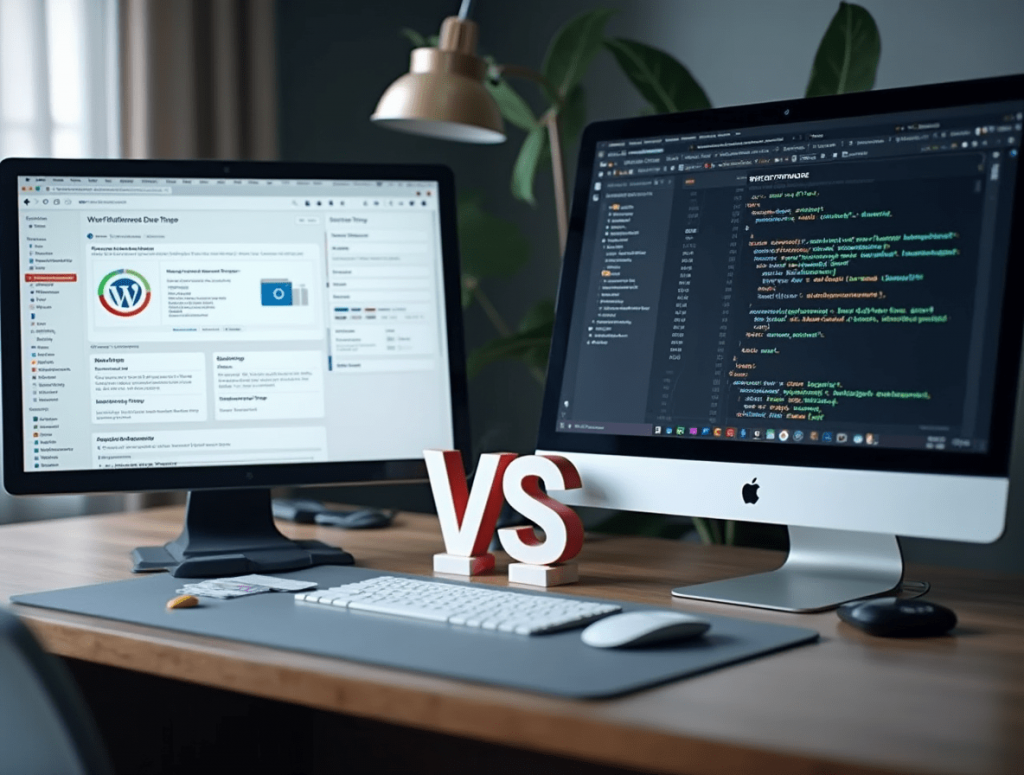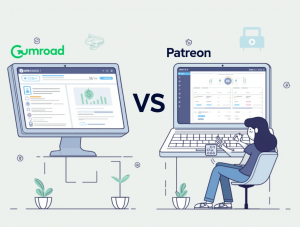
WordPress vs. Webflow: Which Website Builder Offers More Control?
When building a website in 2025, the platform you choose fundamentally shapes what you can create and how you’ll manage it long-term. WordPress powers over 43% of all websites on the internet, while Webflow has emerged as a formidable competitor with over 3.5 million websites using its visual development approach.
For many site owners and developers, the level of control a platform provides is non-negotiable. Whether you’re a business owner looking to maintain your site independently, a designer seeking pixel-perfect implementation, or a developer needing deep customization capabilities, understanding the control dynamics of WordPress versus Webflow is crucial.
This comprehensive comparison examines both platforms through the lens of control – from design flexibility and content management to technical capabilities and ecosystem independence. By the end, you’ll have a clear understanding of which platform aligns with your specific control requirements.
Understanding the Platforms
WordPress: The Established Self-Hosted Solution
WordPress began as a blogging platform in 2003 and evolved into a full content management system (CMS) that runs on your own hosting environment. It offers two distinct versions:
- WordPress.org (self-hosted): The open-source software you install on your own server
- WordPress.com: A hosted service with various pricing tiers
This analysis focuses primarily on self-hosted WordPress, which provides the greatest control potential. WordPress uses PHP and MySQL, with a template-based architecture that separates content from presentation through themes and extends functionality through plugins.
Webflow: The Visual Development Platform
Launched in 2013, Webflow pioneered the concept of visual development, providing professional-grade design capabilities without requiring manual code writing. Webflow is a SaaS (Software as a Service) platform that combines:
- A visual design interface similar to design software
- A CMS for structured content
- Hosting and security management
- Built-in e-commerce capabilities
Unlike WordPress, Webflow generates clean, semantic HTML, CSS, and JavaScript based on your visual designs, with the option to export code.
Design Control Comparison
WordPress Design Control
WordPress approaches design through themes – pre-built design frameworks that determine how your site looks and functions. Design control varies significantly based on your approach:
Pre-built Themes
- Access to thousands of free and premium themes
- Customization through theme options panels
- Limited by theme developer’s implementation choices
- Design changes often restricted to predefined options
Page Builders (Elementor, Divi, etc.)
- Visual drag-and-drop editing
- Expanded design flexibility without coding
- Potential performance impacts
- Often creates complex markup and dependencies
Custom Theme Development
- Complete control through direct code access
- Requires PHP, HTML, CSS knowledge
- Unlimited customization potential
- Higher development cost and time investment
WordPress design control ultimately depends on your technical skills or budget. Non-developers may find themselves constrained by theme parameters, while developers can achieve nearly anything through custom code.
Webflow Design Control
Webflow takes a fundamentally different approach to design:
Visual Development Environment
- Professional-grade design tools in the browser
- Direct manipulation of elements with immediate visual feedback
- Built-in responsive design tools
- No separation between “design” and “development” phases
Class-Based Styling System
- Similar to writing CSS but with visual controls
- Global style systems with inheritances and overrides
- Component-based approach with reusable elements
- Design consistency enforced through the system
Code Output Quality
- Clean, semantic HTML structure
- Optimized CSS without unnecessary code
- Minimal JavaScript footprint
- Production-ready code that passes modern standards
Webflow provides designers with direct control over the implementation rather than going through developer interpretation or theme constraints. However, all design must happen within Webflow’s system – you cannot directly edit the generated code while maintaining the visual editing capabilities.
Content Management Control
WordPress Content Management
WordPress began as a content management system, and this remains its core strength:
Content Structure
- Default post types (pages, posts)
- Custom Post Types for specialized content
- Custom Fields for structured data
- Taxonomies for content organization
- Comprehensive user role management
Content Editing
- Block editor (Gutenberg) for modular content creation
- Classic editor option for traditional approaches
- Revisions and publishing workflows
- Media library with basic image editing
Content APIs
- REST API for headless implementations
- Extensive hooks and filters system
- Database direct access when needed
WordPress offers exceptional content flexibility with multiple approaches to structure and display your content. The learning curve for basic content management is low, while advanced implementations require more technical expertise.
Webflow Content Management
Webflow’s CMS takes a more structured, database-driven approach:
Collection System
- Visual database creation through Collections
- Field types for different content needs
- Reference fields for relationships between collections
- Custom sorting and filtering capabilities
Content Editing
- Structured forms based on collection design
- Draft and publishing workflows
- Team collaboration tools
- Asset manager with basic editing capabilities
Dynamic Content Display
- Template-based collection pages
- Dynamic listings with filtering options
- CMS-driven components
- Conditional visibility based on CMS data
Webflow enforces content structure from the beginning, which improves consistency but can limit flexibility for unique content situations. The system excels when content follows predictable patterns but may require workarounds for edge cases.
Technical Control & Customization
WordPress Technical Control
WordPress provides multiple layers of technical access:
Code Access
- Full access to all core, theme, and plugin files
- Direct database access
- Server configuration control (with self-hosting)
- Complete ownership of all site assets
Extension Ecosystem
- Over 59,000 free plugins in the repository
- Thousands of premium plugin options
- Hooks and filters for modifying core functionality
- Child theme system for theme customization
Development Flexibility
- Multiple development environments available
- Local development capabilities
- Version control integration
- Custom API implementations
WordPress offers virtually unlimited technical control for those with the skills to utilize it. However, this flexibility comes with complexity – managing plugin interactions, security concerns, and performance optimization requires significant expertise.
Webflow Technical Control
Webflow takes a more structured approach to technical implementation:
Code Injection
- Custom code can be added to head or body
- Page-specific script additions
- Asset management for JS libraries
- CSS customization through the Designer
API and Integrations
- Public site read API
- Zapier and Make integrations
- Memberships API (beta)
- Custom code embed capabilities
Limitations
- No direct server-side code execution
- Limited database query capabilities
- No file system access
- Managed hosting environment only
Webflow provides significant front-end control while handling infrastructure concerns automatically. For projects requiring server-side logic, you’ll need to integrate external services or APIs.
Ecosystem Independence
WordPress Ecosystem Independence
WordPress offers remarkable independence:
Hosting Freedom
- Choose any hosting provider
- Migrate between hosts easily
- Self-host on your own servers
- Local development environment options
Data Ownership
- Complete database exports available
- Full file system exports
- Open-source software guarantees access
- No vendor lock-in for core functionality
Ecosystem Choices
- Multiple theme marketplaces
- Plugin alternatives for most functions
- Various development tools and approaches
- No forced upgrade paths
WordPress provides exceptional protection against vendor lock-in, making it a safe long-term investment even as technology evolves.
Webflow Ecosystem Independence
Webflow has more ecosystem constraints:
Hosting Requirements
- Sites must be hosted on Webflow hosting for full functionality
- Code export available but loses CMS capabilities
- Migration requires rebuilding on new platforms
- Backup options limited to static exports
Pricing Structure
- Ongoing subscription required for hosting
- Feature access tied to plan levels
- Site limits based on subscription tier
- Additional costs for specific features (e.g., e-commerce)
Platform Dependence
- Updates and features controlled by Webflow
- Must work within platform constraints
- Integration options determined by Webflow
- Development roadmap not community-driven
While Webflow provides code export options, realistically moving a complex Webflow site to another platform requires substantial rebuilding, creating stronger vendor attachment.
Performance and Scaling Control
WordPress Performance Control
WordPress performance management is largely in your hands:
Hosting Quality
- Your choice of hosting directly impacts performance
- Options from basic shared hosting to enterprise-grade solutions
- Content Delivery Network integration options
- Server-level caching and optimization
Optimization Options
- Caching plugins (WP Rocket, W3 Total Cache)
- Image optimization tools
- Database optimization
- Code minification and combination
Scaling Approaches
- Vertical scaling through better hosting
- Horizontal scaling with load balancing
- Enterprise solutions available
- Complete control over infrastructure decisions
WordPress performance can range from poor to exceptional based entirely on implementation choices and budget. This flexibility is both an advantage and a potential pitfall.
Webflow Performance Control
Webflow handles most performance concerns automatically:
Managed Infrastructure
- Enterprise-grade hosting included
- Global CDN built-in
- Automatic SSL certificates
- DDoS protection standard
Optimization Standards
- Image optimization automatic
- Code minification built-in
- Modern performance practices enforced
- Mobile optimization tools provided
Scaling Limitations
- Traffic limits based on plan tier
- Limited control over server configuration
- No direct optimization of server responses
- Fixed technology stack
Webflow typically delivers excellent performance out-of-the-box but offers fewer options for specialized optimization needs. Most sites benefit from this approach, while extremely high-traffic or unique cases might find the limitations restrictive.
E-commerce Control
WordPress E-commerce Control
WordPress offers multiple e-commerce approaches:
WooCommerce Ecosystem
- Complete control over shopping experience
- Unlimited products and categories
- Extensive payment gateway options
- Advanced shipping and tax rules
- Complete access to order processing logic
Alternative Solutions
- Easy Digital Downloads for digital products
- Membership plugins for subscription content
- Marketplace plugins for multi-vendor setups
- Custom e-commerce implementations possible
International Capabilities
- Multi-currency support
- Tax compliance tools
- Translation capabilities
- Region-specific payment methods
WordPress provides extensive e-commerce flexibility but requires configuration and maintenance of these complex systems.
Webflow E-commerce Control
Webflow offers integrated e-commerce with some limitations:
Native E-commerce
- Visual design control over product pages
- Seamless integration with Webflow design
- Basic product variations
- Integrated payment processing
- Automatic tax calculation
Limitations
- Product limits based on plan tier
- Fewer payment gateway options
- Limited shipping rule complexity
- Simplified inventory management
Extension Options
- Third-party tools via API
- Zapier automations for order processing
- Custom code for specialized needs
- External cart systems possible
Webflow’s e-commerce is ideal for smaller stores with straightforward needs but may become constraining for complex e-commerce operations.
Cost of Control
WordPress Cost Structure
WordPress costs scale with your control needs:
Basic Implementation
- Free WordPress software
- $3-15/month shared hosting
- Free themes and plugins available
- DIY management time investment
Professional Implementation
- $10-100/month improved hosting
- $30-200 premium themes
- $15-200/year premium plugins
- Occasional developer assistance
Enterprise Implementation
- $100-1000+/month managed WordPress hosting
- Custom theme development ($5,000-20,000+)
- Premium plugin ecosystem ($1,000-5,000/year)
- Dedicated development resources
The cost of WordPress scales dramatically based on your specific needs and how much control you want to maintain personally versus delegate to professionals.
Webflow Cost Structure
Webflow has more predictable but potentially higher starting costs:
Site Plans
- Basic Site: $14/month
- CMS Site: $23/month
- Business Site: $39/month
- Enterprise: Custom pricing
E-commerce Plans (additional)
- Standard: $29/month + 2% transaction fee
- Plus: $74/month + 0% transaction fee
- Advanced: $212/month + 0% transaction fee
Workspace Plans (for team access)
- Free: Limited features
- Core: $14 per person/month
- Growth: $24 per person/month
Webflow pricing is more straightforward but lacks the entry-level affordability of basic WordPress implementations. The value equation depends on how much you value the integrated tools versus assembling and maintaining your own stack.
Learning Curve and Knowledge Requirements
WordPress Learning Requirements
WordPress knowledge scales with control desires:
Basic Content Management
- Minimal technical knowledge required
- Familiar word processor-like interface
- Standard admin dashboard navigation
- Moderate learning curve for basics
Intermediate Customization
- Basic HTML/CSS for minor theme adjustments
- Plugin configuration understanding
- Admin settings familiarity
- SEO and performance basics
Advanced Implementation
- PHP programming for custom functionality
- Advanced CSS/JavaScript for front-end control
- Database structure knowledge
- Server management skills
- Security best practices
WordPress can be approached at multiple knowledge levels, but deep control requires significant technical skills or budget for professional help.
Webflow Learning Requirements
Webflow has a steeper initial curve but more contained knowledge requirements:
Design System Understanding
- Box model comprehension
- Layout concepts (Flexbox, Grid)
- Style inheritance principles
- Component-based design thinking
CMS Implementation
- Database structure concepts
- Content relationship modeling
- Template design principles
- Dynamic content binding
Interactions and Advanced Features
- Animation timing principles
- Conditional logic
- Form handling concepts
- API integration basics
Webflow requires learning its specific interface and approach, but this knowledge is contained within one system rather than spread across multiple technologies.
Security Control
WordPress Security Control
WordPress security is largely your responsibility:
Core Responsibilities
- Keeping WordPress core updated
- Plugin and theme update management
- Strong password enforcement
- User permission management
- Backup implementation
Security Options
- Security plugins (Wordfence, Sucuri)
- Two-factor authentication
- Custom security rules
- Malware scanning and removal
- Firewall configuration
Risk Factors
- Plugin vulnerabilities
- Hosting security lapses
- Password management issues
- Update negligence
- Large attack surface
WordPress offers powerful security tools but requires diligent implementation and ongoing maintenance to remain secure.
Webflow Security Control
Webflow handles most security concerns automatically:
Platform Security
- Managed infrastructure security
- DDoS protection
- SSL certificate management
- Regular platform security updates
- Professional security team
User Controls
- Team permission settings
- Password requirements
- Two-factor authentication
- Session management
Limited Attack Surface
- Reduced plugin vulnerability risk
- No direct database access
- Limited injection points
- Managed code execution
Webflow significantly reduces security management burden at the cost of some control over specific security implementations.
Real-World Control Scenarios
Content Marketing Website
WordPress Advantages
- Extensive blogging tools and workflows
- SEO plugin ecosystem (Yoast, Rank Math)
- Content scheduling and management
- Author management for teams
- Comment moderation capabilities
Webflow Advantages
- Design consistency across content
- Visual design of content templates
- Clean code output for SEO benefits
- Structured content approach
- Performance consistency
Control Verdict: WordPress offers more content workflow control, while Webflow provides better design implementation control.
E-commerce Store
WordPress Advantages
- Unlimited products and categories
- Advanced inventory management
- Multiple payment and shipping options
- Order process customization
- Full access to customer data
Webflow Advantages
- Consistent design across product pages
- Visual product page creation
- Integrated system management
- Performance reliability
- Simpler setup process
Control Verdict: WordPress provides deeper e-commerce control but requires more management, while Webflow offers streamlined control with some limitations.
Custom Web Application
WordPress Advantages
- PHP application framework capabilities
- Custom database query flexibility
- User management and authentication
- Plugin foundation for core functionality
- Direct server access
Webflow Advantages
- Front-end visual precision
- Animation and interaction design
- Clean code foundation
- Reliable infrastructure
- Faster initial development
Control Verdict: WordPress offers necessary back-end control for true applications, while Webflow excels at front-end implementation control.
Making Your Decision: A Control Framework
When deciding between WordPress and Webflow, assess your priorities across these control dimensions:
- Design Implementation Control: Who needs to control the design, and what skills do they have?
- Content Management Control: What content structures do you need, and how will they evolve?
- Technical Customization Needs: What server-side functionality is essential?
- Budget Control: What’s your tolerance for variable versus fixed costs?
- Maintenance Control: Who will manage ongoing updates and security?
- Ecosystem Independence: How important is avoiding vendor lock-in?
Conclusion
WordPress and Webflow represent fundamentally different approaches to website control:
WordPress offers virtually unlimited control potential with the tradeoff of increased complexity and management responsibility. It’s ideal for those who:
- Need extensive customization beyond visual design
- Require specific server-side functionality
- Value complete ownership and portability
- Have technical resources available
- Want maximum ecosystem flexibility
Webflow provides substantial visual and design control within a more structured ecosystem. It’s perfect for those who:
- Prioritize design implementation precision
- Value integrated systems over customization depth
- Prefer managed infrastructure to control complexity
- Need faster design-to-launch timelines
- Want professional results without extensive technical knowledge
The “best” choice depends entirely on which dimensions of control matter most to your specific project and team capabilities. Many organizations even use both platforms strategically for different projects based on their unique requirements.
FAQ Section
Can I migrate from WordPress to Webflow easily?
Migration from WordPress to Webflow requires manual recreation of designs and content import. While Webflow offers WordPress import tools, complex sites usually need significant rebuilding to maintain design integrity and functionality.
Does Webflow have plugins like WordPress?
Webflow doesn’t have traditional plugins but offers integrations through custom code, embeds, and third-party services like Zapier. The ecosystem is more controlled but lacks the extensibility of WordPress’s plugin architecture.
Which platform gives designers more control?
Webflow typically offers designers more direct control over implementation without developer dependence. WordPress provides design freedom but often requires technical knowledge to implement custom designs accurately.
Can developers extend either platform with custom code?
WordPress offers comprehensive development possibilities through custom themes, plugins, and direct server access. Webflow allows front-end customization through custom code injection but limits server-side development capabilities.
Which platform is more future-proof?
WordPress’s open-source nature and massive ecosystem provide strong future-proofing through community support and adaptability. Webflow offers future-proofing through platform evolution but creates some vendor dependence.
Can I handle everything myself on either platform?
Basic WordPress sites can be self-managed with minimal technical knowledge, but advanced control requires technical skills. Webflow consolidates more capabilities into its visual interface, potentially reducing technical skill requirements for comparable results.














